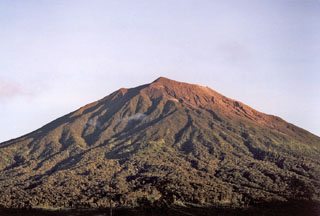Report on Kerinci (Indonesia) — December 2020
Bulletin of the Global Volcanism Network, vol. 45, no. 12 (December 2020)
Managing Editor: Edward Venzke.
Edited by Kadie L. Bennis.
Kerinci (Indonesia) Intermittent ash plumes and gas-and-steam emissions during June-November 2020
Please cite this report as:
Global Volcanism Program, 2020. Report on Kerinci (Indonesia) (Bennis, K.L., and Venzke, E., eds.). Bulletin of the Global Volcanism Network, 45:12. Smithsonian Institution. https://doi.org/10.5479/si.GVP.BGVN202012-261170
Kerinci
Indonesia
1.697°S, 101.264°E; summit elev. 3800 m
All times are local (unless otherwise noted)
Kerinci, located in Sumatra, Indonesia, has had numerous explosive eruptions since 1838, with more recent activity characterized by gas-and-steam and ash plumes. The current eruptive episode began in April 2018 and has recently consisted of intermittent brown ash emissions and white gas-and-steam emissions (BGVN 45:07); similar activity continued from June through November 2020. Information primarily comes from the Pusat Vulkanologi dan Mitigasi Bencana Geologi (PVMBG, also known as CVGHM, or the Center of Volcanology and Geological Hazard Mitigation), MAGMA Indonesia, the Darwin Volcanic Ash Advisory Centre (VAAC), and satellite data.
Activity has been characterized by dominantly white and brown gas-and-steam emissions and occasional ash plumes, according to PVMBG. Near daily gas-and-steam emissions were observed rising 50-6,400 m above the crater throughout the reporting period: beginning in late July and continuing intermittently though November. [Sentinel-2 satellite imagery showed frequent brown emissions rising above the summit crater at varying intensities and drifting in different directions from 27 July 2020 to 4 November, though the intensity gradually declined over time (figure 21).]
During June through July the only activity reported by PVMBG consisted of white gas-and-steam emissions and brown emissions. On 4 June white gas-and-steam emissions rose to a maximum height of 6.4 km above the crater. White-and-brown emissions rose to a maximum height of 700 m above the crater on 2 June and 28 July.
Continuous white-and-brown gas-and-steam emissions were reported in August that rose 50-1,000 m above the crater. The number of ash plumes reported during this month increased compared to the previous months. In a Volcano Observatory Notice for Aviation (VONA) issued on 7 August at 1024, PVMBG reported an ash plume that rose 600 m above the crater and drifted E, SE, and NE. In addition, the Darwin VAAC released two notices that described continuous minor ash emissions rising to 4.3 km altitude and drifting E and NE. On 9 August an ash plume rose 600 m above the crater and drifted ENE at 1140. An ash plume was observed rising to a maximum of 1 km above the crater, drifting E, SE, and NE on 12 August at 1602, according to a PVMBG VONA and Darwin VAAC advisory. The following day, brown emissions rose to a maximum of 1 km above the crater and were accompanied by a 600-m-high ash plume that drifted ENE at 1225. Ground observers on 15 August reported an eruption column that rose to 4.6 km altitude; PVMBG described brown ash emissions up to 800 m above the crater drifting NW at 0731 (figure 22). During 20-21 August pilots reported an ash plume rising 150-770 m above the crater drifting NE and SW, respectively.
 |
Figure 22. Webcam image of an ash plume rising above Kerinci on 15 August 2020. Courtesy of MAGMA Indonesia. |
Activity in September had decreased slightly compared to the previous month, characterized by only white-and-brown gas-and-steam emissions that rose 50-300 m above the crater; solely brown emissions were observed on 30 September and rose 50-100 m above the crater. This low level of activity persisted into October, with white gas-and-steam emissions to 50-200 m above the crater and brown emissions rising 50-300 m above the crater. On 16 October PVMBG released a VONA at 0340 that reported an ash plume rising 687 m above the crater and drifting NE. On 17 October white, brown, and black ash plumes that rose 100-800 m above the crater drifted NE according to both PVMBG and a Darwin VAAC advisory (figure 23). During 18-19 October white, brown, and black ash emissions rose up to 400 m above the crater and drifted NE and E.
 |
Figure 23. Webcam image of a brown ash emission from Kerinci on 17 October 2020. Courtesy of MAGMA Indonesia. |
Geological Summary. Gunung Kerinci in central Sumatra forms Indonesia's highest volcano and is one of the most active in Sumatra. It is capped by an unvegetated young summit cone that was constructed NE of an older crater remnant. There is a deep 600-m-wide summit crater often partially filled by a small crater lake that lies on the NE crater floor, opposite the SW-rim summit. The massive 13 x 25 km wide volcano towers 2400-3300 m above surrounding plains and is elongated in a N-S direction. Frequently active, Kerinci has been the source of numerous moderate explosive eruptions since its first recorded eruption in 1838.
Information Contacts: Pusat Vulkanologi dan Mitigasi Bencana Geologi (PVMBG, also known as Indonesian Center for Volcanology and Geological Hazard Mitigation, CVGHM), Jalan Diponegoro 57, Bandung 40122, Indonesia (URL: http://www.vsi.esdm.go.id/); MAGMA Indonesia, Kementerian Energi dan Sumber Daya Mineral (URL: https://magma.vsi.esdm.go.id/); Darwin Volcanic Ash Advisory Centre (VAAC), Bureau of Meteorology, Northern Territory Regional Office, PO Box 40050, Casuarina, NT 0811, Australia (URL: http://www.bom.gov.au/info/vaac/); Sentinel Hub Playground (URL: https://www.sentinel-hub.com/explore/sentinel-playground).


